Intel SSD 520 Review: Cherryville Brings Reliability to SandForce
by Anand Lal Shimpi on February 6, 2012 11:00 AM ESTRandom Read/Write Speed
The four corners of SSD performance are as follows: random read, random write, sequential read and sequential write speed. Random accesses are generally small in size, while sequential accesses tend to be larger and thus we have the four Iometer tests we use in all of our reviews.
Our first test writes 4KB in a completely random pattern over an 8GB space of the drive to simulate the sort of random access that you'd see on an OS drive (even this is more stressful than a normal desktop user would see). I perform three concurrent IOs and run the test for 3 minutes. The results reported are in average MB/s over the entire time. We use both standard pseudo randomly generated data for each write as well as fully random data to show you both the maximum and minimum performance offered by SandForce based drives in these tests. The average performance of SF drives will likely be somewhere in between the two values for each drive you see in the graphs. For an understanding of why this matters, read our original SandForce article.
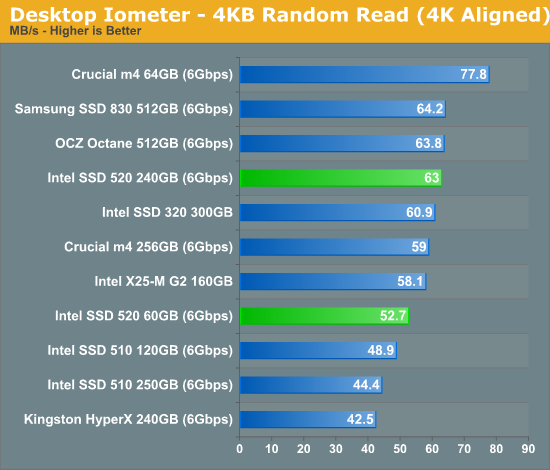
Random read performance seems to have topped out around 60MB/s for most drives and the 520 is no different here.
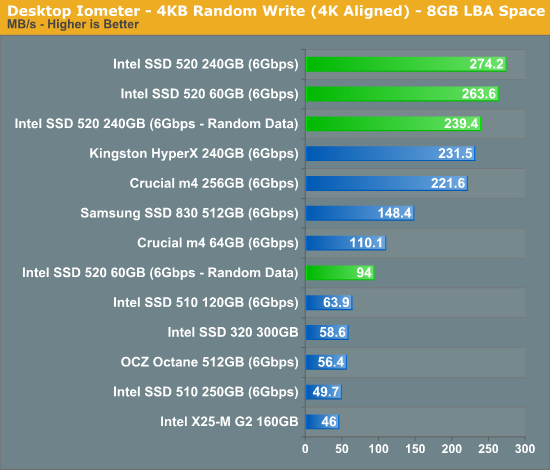
Random write performance, especially with highly compressible data sets the 520 performs beautifully - even outpacing the SF-2281 based Kingston HyperX.
Many of you have asked for random write performance at higher queue depths. What I have below is our 4KB random write test performed at a queue depth of 32 instead of 3. While the vast majority of desktop usage models experience queue depths of 0 - 5, higher depths are possible in heavy I/O (and multi-user) workloads:
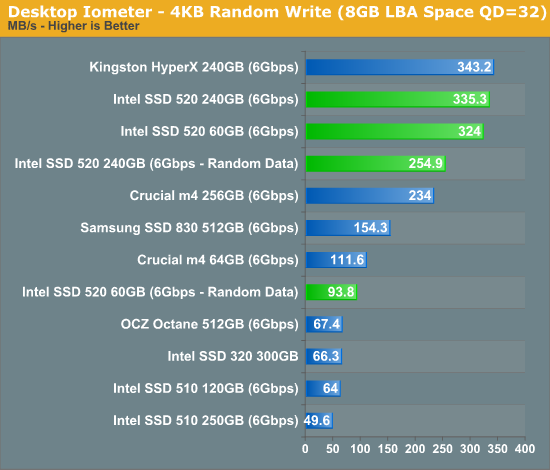
At higher queue depths the HyperX catches up to and surpassed the 520, perhaps indicating that Intel has done some work to optimize low queue depth performance on the 520 (likely what most end users will encounter).
Sequential Read/Write Speed
To measure sequential performance I ran a 1 minute long 128KB sequential test over the entire span of the drive at a queue depth of 1. The results reported are in average MB/s over the entire test length.
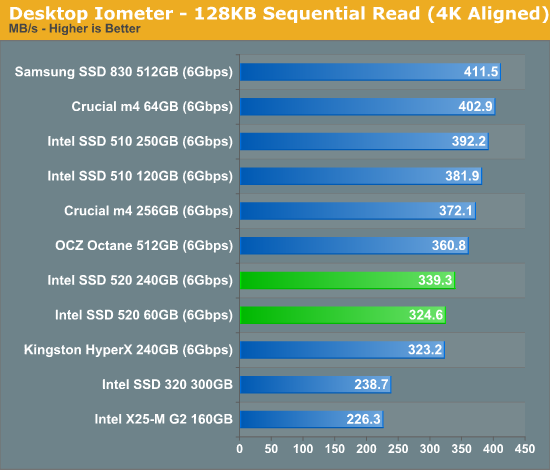
Sequential read performance is actually a bit lower than Intel's 510, but still higher than a standard SF-2281 drive.
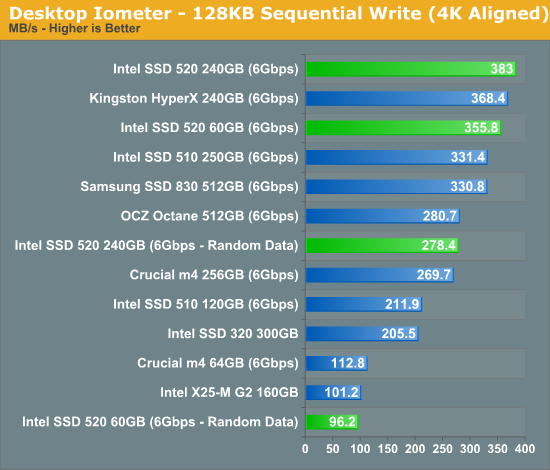
It's important to note just how close the 520's peak random write performance is to its sequential write performance. A big part of this is obviously that the SF-2281 is throwing away a lot of the data it has to write, but even if we compare incompressible 4KB random write to highly compressible 128KB sequential write we see a good ratio. The closer those two values are the more optimal the controller/firmware design is as, in theory, smaller random writes should be grouped to effectively become large sequential writes from the perspective of the NAND.










138 Comments
View All Comments
km23 - Monday, February 6, 2012 - link
What drive would you suggest for a Mac Pro? I have an early 2008 with 3G connection. I keep reading about the Mercury drives from Macsales. Any suggestions? Thanks.Beenthere - Monday, February 6, 2012 - link
WAIT for SSD makers to sort the Bugs out of their SSDs. Contrary to what Intel says, I think that's the only way we will have any idea of the reliability of the 520 series SSDs. Maybe in 12 months enough guinea pigs will have found most of the Bugs.troystarr - Tuesday, February 7, 2012 - link
I understand why IOPS would go down for smaller capacity drives with fewer NAND die to interleave, but I'm curious why it would go down when the capacity goes up.haa - Tuesday, February 7, 2012 - link
When using SSDs in laptops whole disk encryption is often required (and easy to enable with e.g. FileVault 2 on Macs) so it is not just a corner case as the computer is writing incompressible (encrypted) data all the time, bringing out the worst case performance case probably pretty soon...Cow86 - Tuesday, February 7, 2012 - link
So now that the belated 520 has finally shown up (originally Q4 according to the roadmap), will the other SSD that also should've been out already also show up soon? The successor to the intel 311, hawley creek? Kinda been waiting for that one for a reliable, and hopefully cheaper, caching SSD....Enough capacity means getting 180GB or more, which is too expensive from any vendor at this time for me, and I'm not too sure about using a 60 GB SSD for caching either, with regards to reliability....Hawley Creek seems to have completely dissapeared off the radar though :/fausto412 - Tuesday, February 7, 2012 - link
these things still have reliability issues?Westyfield2 - Tuesday, February 7, 2012 - link
Intel say:"Superior data protection features: The new Intel SSD 520 Series offers the best security features of any Intel SSD to date and comes preconfigured with Intel® Advanced Encryption Standard New Instructions (Intel® AES-NI) 256-bit encryption capabilities. In the event of theft or loss of your computer, you have the peace of mind that your personal data is secured by an advanced encryption technology. Additionally, the Intel SSD 520 Series contains “End-to-End Data Protection” ensuring integrity of stored data from the computer to the SSD and back."
Any details Anand? Here's a forum thread about FDE on the Intel 320. http://communities.intel.com/thread/20537?tstart=0
I, for one, would be very interested in an FDE SSD (I remember Samsung did one a few years ago, but that's all gone quiet).
panthal - Tuesday, February 7, 2012 - link
I find it odd Anand or anyone else doesn't think what Intel as has done is shady as hell.All the issues were not with the Sandforce controller.It was also partly how the Intel chip-sets handled power schemes and other advanced parts of the power management.Intel one was one of the MAIN vendors pushing for some of the more advanced power settings,then DISABLED them on their own Intel branded SSD drives.What does that tell you?The Sandforce fixes didn't come because Intel didn't want them sorted till it got closer to time for their own Intel branded Sandforce drives.They helped just enough to get the last firmware pushed that solved most the Sandforce issues.
Call it conspiracy if you want,but it's all there if you care to look.
Beenthere - Tuesday, February 7, 2012 - link
Perish the thought that Intel would ever operate in any manner than with the utmost integrity and respect for it's customers and the PC industry.http://www.theinquirer.net/inquirer/news/2120866/i...
NitroWare - Wednesday, February 8, 2012 - link
Some of the SATA power management schemes were convinced years ago before cheap SSDs became mainstream. Intel did not invent SATA by itself.No logic is perfect, even from Intel.
As for claiming Intel has somehow thrown a wrench into the gears thats a bit foolish. Corsair, OCZ and Kingston amongst others put their reputations on the line when these issues arise. These firms do not sell $300-$2000 CPUs that make up their revenue. For some tech firms, a product recall is the last thing they will ever want to do.
Apparently these cheap SATA III SandForce SSDs are selling like hotcakes in some regions from what some channel distributors tell me and they can't keep enough stock to meet demand or the vendors have to shift stock allocations between regions to meet such demands, annoying other regions.
Consumers want cheap SSDs, regardless of who they are from. No consumer will buy an ultra enterprise product for $2000. You can not have your cake and eat it too.
If there is a genuine issue with a product, either a fix will be made available or worst case swap under warranty for a revised product.
For specific motherboard support blame the mobo vendors. They are reluctant to patch BIOSes for older models such as adding the latest Intel Option ROM. Many angles to this. Manpower, validation, lazy, no care factor, pushing newer models, open a can of worms and so on. They can get the latest drivers, firmwares or fixes if they want, if they still buy particular chips they are provided with support. If they don't use this support its their fault.
Some are even reluctant to patch new boards.